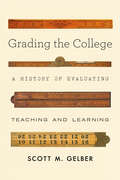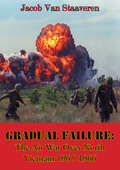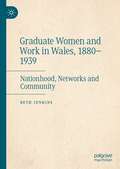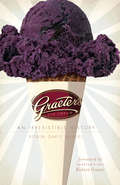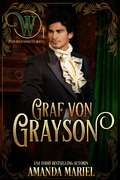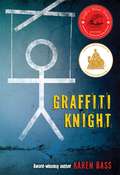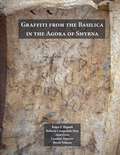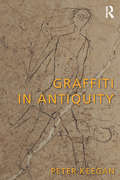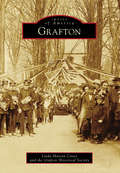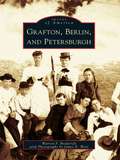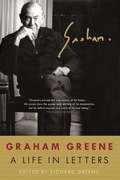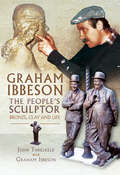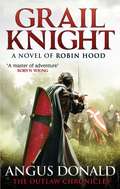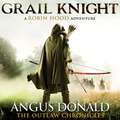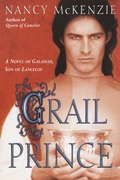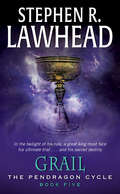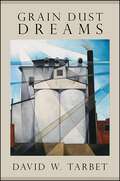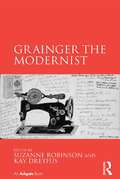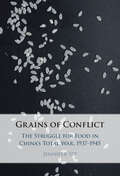- Table View
- List View
Graciela: One Woman's Story of War, Survival, and Perseverance in the Peruvian Andes
by Nicole Coffey Kellett with Graciela Orihuela RochaGraciela chronicles the life of a Quechua-speaking Indigenous woman in the remote Andean highlands during the war in Peru that killed seventy thousand people and displaced hundreds of thousands more in the 1980s and 1990s. The book traces her early years as a young child living in an epicenter of violence to her contemporary life as a postwar survivor. Graciela Orihuela Rocha&’s history embodies the horrors, injustices, promises, and challenges faced by countless individuals who endured and survived the war. Her story provides intimate insights into deep-seated divisions within Peruvian society that center around skin color, gender, language, and ties to the land. These fault lines have endured to the present day, fostering discontent and violence in Peru.Through Graciela&’s story we not only learn of trauma and dehumanization but also resilience, strength, and perseverance. Graciela&’s history provides insight into the systemic challenges of determining truth, implementing justice, and envisioning reconciliation in a country where calls for equality and justice remain unrealized for the most marginalized.
Grade B Reporter: Reflections of a Grade B Reporter
by Martin BellMartin Bell has stood in war zones as both a soldier and a journalist. From Vietnam to Bosnia to Iraq, he has witnessed first-hand the dramatic changes in how conflicts are fought and how they are reported. He has seen the truth degraded in the name of balance and good taste – grief and pain censored so the viewers are not disturbed. In an age of international terror, where journalists themselves have become targets, more and more reports are issued from the sidelines. The dominance of social media has ushered in a post-truth world: Twitter rumours and unverifiable videos abound, and TV news seeks to entertain rather than inform. In this compelling account, one of the outstanding journalists of our time provides a moving, personal account of war and issues an impassioned call to put the substance back in our news.
Grading the College: A History of Evaluating Teaching and Learning
by Scott M. GelberA comprehensive history of evaluation in American higher education.In Grading the College, Scott M. Gelber offers a comprehensive history of evaluating teaching and learning in higher education. He complicates the conventional narrative that portrays evaluation as a newfangled assault on the integrity of higher education while acknowledging that there are many compelling reasons to oppose those practices. The evaluation of teaching and learning, Gelber argues, presented genuine dilemmas that have attracted the attention of faculty members and academic leaders since the 1920s. Especially during the peak era of faculty authority that followed the end of the Second World War, significant numbers of professors and administrators believed that evaluation might improve institutional performance, reduce the bias inherent in traditional methods of supervision, strengthen communication with laypersons, and encourage a more deliberate focus on the distinctive goals of college.Gelber reveals the extent to which professors and academic interest groups participated in the development of our most common evaluation instruments, including student course questionnaires, achievement tests, surveys, rubrics, rankings, and accreditation self-studies. Although these efforts may seem distant from the present era of shortsighted scrutiny and ill-conceived comparisons, Gelber demonstrates that the evaluation of college teaching and learning has long consisted of a set of intellectually sophisticated questions that have engaged, and could continue to engage, faculty members and their advocates. By providing a deeper understanding of how evaluation operated before the dawn of high-stakes accountability, Grading the College seeks to promote productive conversations about current attempts to define and measure the purposes of American higher education.
Grados de pasión
by Yolanda Díaz de TuestaUna novela histórica llena de pasión y venganza ambientada a caballo entre Inglaterra y España en el siglo XIX: una rica heredera y un hombre dispuesto a todo por arrebatarle sus tierras. Terrosa, Extremadura, agosto de 1850. Un calor sofocante y despiadado. Una mujer que aguarda la llegada de un carruaje. Un viajero que cambiará el futuro del pueblo. Hace tiempo que Candela asumió que nunca obtendría el amor de su padre, Bernardo Salazar, el hombre al que más admira y al que más le gustaría odiar. Ahora solo desea casarse con la persona que ella ya ha elegido, llenar por fin esa necesidad de afecto y vivir para siempre en Terrosa mientras disfruta de un futuro que imagina tranquilo y feliz. Sin embargo, todo se tuerce cuando su padre regresa de su estancia en Inglaterra de forma precipitada al pueblo y le presenta al inglés con quien ha acordado su matrimonio. Lord William Caldecourt, décimo conde de Waldwick, llega a Terrosa con la intención de ponerlo todo patas arriba. Es un ser despiadado que está dispuesto a terminar con una larga venganza. O eso se repite a menudo, pues es lo que le juró a su madre y así se lo reclama el recuerdo de su familia, destruida por Bernardo Salazar. Pero, para su desdicha, desde que contempló el hermoso rostro de Candela en un daguerrotipo, vive pensando que quizá esa mujer que era solo el instrumento para lograr su venganza pueda convertirse en la persona que le libere de los oscuros designios del destino.
Gradual Failure: The Air War Over North Vietnam 1965-1966 [Illustrated Edition]
by Jacob Van StaaverenIncludes over 100 maps, plans and illustrationsThe United States Air Force reached its nadir during the opening two years of the Rolling Thunder air campaign in North Vietnam. Never had the Air Force operated with so many restraints and to so little effect. These pages are painful but necessary reading for all who care about the nation's military power.Jacob Van Staaveren wrote this book in the 1970s near the end of his distinguished government service, which began during the occupation of Japan; the University of Washington Press published his book on that experience in 1995. He was an Air Force historian in Korea during the Korean War, and he began to write about the Vietnam War while it was still being fought. His volume on the air war in Laos was declassified and published in 1993. Now this volume on the air war in North Vietnam has also been declassified and is being published for the first time. Although he retired to McMinnville, Oregon, a number of years ago, we asked him to review the manuscript and make any changes that seemed warranted. For the most part, this is the book he wrote soon after the war.Readers of this volume will also want to read the sequel, Wayne Thompson's To Hanoi and Back: The U.S. Air Force and North Vietnam, 1966-1973, which tells the more encouraging story of how the Air Force employed airpower to far greater effect using a combination of better doctrine, tactics, technology, and training.
Graduate Women and Work in Wales, 1880–1939: Nationhood, Networks and Community
by Beth JenkinsThis book traces the social backgrounds, educational experiences and subsequent lives of women who attended the university colleges in Wales from their inception to the outbreak of the Second World War. Using a sample of 2,000 graduates, the book foregrounds the experience of working-class women and critically assesses the claim of social inclusivity built around education in Wales. It charts changes and continuities in women’s career prospects; explores graduates’ relationship with the communities in which they studied, lived, and worked; and, finally, examines the extensive networks which underpinned their personal and professional lives.
Grady Baby: A Year in the Life of Atlanta's Grady Hospital
by Jerry GentryGranted unprecedented behind-the-scenes access to the maternity ward of Atlanta's sprawling public hospital, Jerry Gentry binds together stories of women, medical residents, nurses, and midwives. In this teeming facility that never closes, he shows how their sorrows, struggles, and spiritual fortitude join at the moment when life begins. Gentry tells these stories in a style and pace that mirrors life in the hospital. Scenes may change rapidly or linger on the birth of a child or an older woman's struggle with addiction. Some individuals reappear throughout the narrative while some flash by and then are gone, leaving an indelible imprint on the memory. In his narrative, Gentry follows four principal stories: A young, single woman is having her second child. She gradually reveals that her relationship with her boyfriend is a violent one. An older woman—a “Grady Baby” and lifelong Grady patient—emerges as a kind of spiritual muse. In the charity hospital, a Brazilian émigré is pregnant by a man from a wealthy Atlanta family. A woman with AIDS faces the trials of a mixed-race relationship and the terrifying question—will my baby have the virus? Never maudlin, Grady Baby presents hard choices—some wise, some not—made by women enduring tough realities. The term “Grady Baby” has been traditionally a pejorative, stereotyping the race and class of patients, but it can also be a term of pride and strength. With an insider's eye and unflinching, humanizing narrative voice, Gentry reveals the battles, failures, and triumphs that occur in one year in the place where birth and the hardships of urban life collide.
Graeter's Ice Cream: An Irresistible History
by Robin Davis HeigelHistorians may not agree on when or where ice cream was first developed, but there is little debate that one of the best versions of this sweet treat today is made by Graeter's Ice Cream in Cincinnati. Louis Charles Graeter started his ice cream business in 1870, hand churning the concoction in a cylinder pot set in a larger bucket of ice and salt, a contraption known as the French pot. The ice cream business in America has evolved to favor mass production, but little has changed in the way Graeter's makes ice cream today, much to the delight of the company's many thousands of devotees. Graeter's is churned from the same mix of cream, sugar and eggs, still made in two-gallon batches and still owned by the same family, now in its fourth generation. Journey with Robin Davis Heigel, food editor with the Columbus Dispatch, as she recounts the history of the company that has enchanted millions of taste buds across the country.
Graf von Grayson
by Amanda MarielDamien Archer, Graf von Grayson, und Lady Charlotte Lawson sind Gegensätze, wie sie im Buche stehen: Seinen dunklen Haaren stehen ihre blonden Locken und blauen Augen gegenüber, ihre Alabasterhaut bildet einen krassen Kontrast zu Damiens sonnengebräuntem Teint. Er ist 1,90m groß, während sie nicht einmal 1,60m misst. Ihre Lebensfreude könnte im Vergleich zu seiner nachdenklichen Art nicht extremer sein. Aber am ärgerlichsten ist seine Tendenz, alle gesellschaftlichen Regeln zu brechen, während sie ihnen tadellos Folge leistet. Damien wünscht sich nichts mehr, als sein Leben dem Alkohol, Wetten und Frauen zu widmen, während Charlotte ihre Tage mit Teekränzchen, Bällen und Musikabenden verbringt. Sie ist eine wahre Lady und er ein sturköpfiger Schurke. Als sich ihre Wege kreuzen, haben sie ausreichend Gründe, um sich wieder in entgegengesetzte Richtungen voneinander zu entfernen, aber sie können nicht voneinander lassen. Die Leidenschaft glimmt auf und bringt beide in Gefahr: Sie könnten nicht nur ihren Ruf, sondern, viel schlimmer, ihre Herzen aneinander verlieren
Graffiti Knight
by Karen BassAfter a childhood cut short by World War II and the harsh strictures of Nazi Germany, fifteen-year-old Wilm seeks freedom of expression in a city governed by brutal police and oppressive Soviet forces. His graffiti successfully embarrasses the police, but it also endangers the people Wilm holds dear.
Graffiti from the Basilica in the Agora of Smyrna (ISAW Monographs #1)
by Roger S. Bagnall, Roberta Casagrande-Kim, Akın Ersoy, and Cumhur TanrıverAn in-depth archaeological reportfeaturing graffiti found during a recent excavation at the Ancient Greek cityof Smyrna. The graffiti published in this richly-illustrated volume were discovered during an excavation of the Roman basilica in the Ancient Greek city of Smyrna, known today as Izmir, which is situated on the Aegean coast of modern Turkey. The project, which began in 2003, has unearthed a multitude of graffiti and drawings encompassing a wide range of subjects and interests, including local politics, nautical vessels, sex, and wordplay. Each graffito artifact holds the potential for vast historical and cultural data, rescued in this volume from the passage of time and razing ambitions of urban development. Given the city’s history, the potential wealth of knowledge to be gleamed from these discoveries is substantial: Smyrna has an uninterrupted history of settlement since the Neolithic–Copper ages, and remains today a major city and Mediterranean seaport at the crossroads of key trade routes. The present volume provides comprehensive editions of the texts, descriptions of the drawings, and an extensive introduction to the subjects of the graffiti, how they were produced, and who was responsible for them. A complete set of color photographs is included.
Graffiti in Antiquity
by Peter KeeganAncient graffiti - hundreds of thousands of informal, ephemeral texts spanning millennia - offer a patchwork of fragmentary conversations in a variety of languages spread across the Mediterranean world. Cut, painted, inked or traced in charcoal, the surviving graffiti present a layer of lived experience in the ancient world unavailable from other sources. Graffiti in Antiquity reveals how and why the inhabitants of Greece and Rome - men and women and free and enslaved - formulated written and visual messages about themselves and the world around them as graffiti. The sources - drawn from 800 BCE to 600 CE - are examined both within their individual historical, cultural and archaeological contexts and thematically, allowing for an exploration of social identity in the urban society of the ancient world. An analysis of one of the most lively and engaged forms of personal communication and protest, Graffiti in Antiquity introduces a new way of reading sociocultural relationships among ordinary people living in the ancient world.
Grafton (Images of America)
by Linda Marean Casey Grafton Historical SocietyNestled in the hills 38 miles west of Boston, the area that would become Grafton originally belonged to the Nipmuc Indians. In the mid-1600s, John Eliot, a Puritan missionary, traveled throughout Massachusetts converting the natives to Christianity. He created a series of "praying Indian" villages, including Hassanamesit. In 1728, most of Hassanamesit was purchased by a group of investors, and in 1735 it was incorporated as the town of Grafton. By the early 19th century, Grafton was a national leader in leather tanning and shoe production. Textile mills appeared along the rivers, attracting emigrant workers from Canada and Europe. Three geographic areas evolved, each with its own identity: Grafton Center, North Grafton, and South Grafton. Today, residents celebrate the differences and salute the forces that brought them together to form one united town. Grafton is the birthplace of the famous Willard clock makers--Simon, Benjamin, Ephraim, and Aaron--whose home and clock shop are now the Willard House and Clock Museum. Grafton is the birthplace of Robert Bailey Thomas, the founder, editor, and publisher of the Old Farmer's Almanac. Native Jerome Wheelock invented a steam valve system, revolutionizing transportation worldwide. Grafton is also the childhood home of noted American poet Frank O'Hara.
Grafton, Berlin, and Petersburgh (Images of America)
by Warren F. Broderick James E. WestGrafton, Berlin, and Petersburgh captures a vivid picture of a long lost way of life in upstate New York. Filled with unforgettable photographs by James E. West, the book artistically portrays the proud people, quiet streets, and breathtaking panoramas of eastern Rensselaer County from1880 to 1915. For the first time, these historical photographsfrom the West collection are presented in a single volume. Anative of Grafton, James Emmett West set up a photographic business in 1878, began working in earnest in the Grafton-Berlin-Petersburgh region, and traveled in hishorse-drawn wagon, f ully equipped with a studio and darkroom.
Graham Greene: A Life in Letters
by Richard GreeneThere have been a number of Graham Greene biographies, but none has captured his voice, his loves, hates, family and friends-intimate and writerly-or his deep understanding of the world, like this astonishing collection of letters. Graham Greene is one of the few modern novelists who can be called great. In the course of his long and eventful life (1904--1991), he wrote tens of thousands of letters to family, friends, writers, publishers and others involved in his various interests and causes. A Life in Letters presents a fresh and engrossing account of his life, career and mind in his own words. Meticulously chosen and engagingly annotated, this selection of letters-many of them seen here for the first time-gives an entirely new perspective on a life that combined literary achievement, political action, espionage, exotic travel and romantic entanglement.In several letters, the individuals, events or places described provide the inspiration for characters, episodes or locations found in his later fiction. The correspondence describes his travels in Mexico, Africa, Malaya, Vietnam, Haiti, Cuba, Sierra Leone, Liberia and other trouble spots, where he observed the struggles of victims and victors with a compassionate and truthful eye. The volume includes a vast number of unpublished letters to authors Evelyn Waugh, Auberon Waugh, Anthony Powell, Edith Sitwell, R.K. Narayan and Muriel Spark, and to other more notorious individuals such as the double-agent Kim Philby. Some of these letters dispute previous assessments of his character, such as his alleged anti-Semitism or obscenity, and he emerges as a man of deep integrity, decency and courage. Others reveal the agonies of his romantic life, especially his relations with his wife, Vivien Greene, and with one of his mistresses, Catherine Walston. The letters can be poignant, despairing, amorous, furious or amusing, but the sheer range of experience contained in them will astound everyone who reads this book.From the Hardcover edition.
Graham Ibbeson, The People's Sculptor: Bronze, Clay and Life
by John Trelkeld Graham IbbesonJust William. The name conjures memories of Richmal Cromptons favourite character. No childhood was complete without the outrageous exploits of William and his constant companions, The Outlaws. Sculptor Graham Ibbeson was beguiled by the words in the bestselling books and by the portrait of William on the front covers, a cheeky boy with tousled hair and a catapult sticking out of a pocket. Decades later Graham produced his own version of William, immortalized in fibre glass for the Bethnal Green Museum of Childhood, to mark the centenary of Cromptons birth. The Daily Mirror was so impressed by this tribute to one of fictions wonderful characters that one of its staff men photographed Graham walking with the statue up one of the last remaining cobbled streets in Barnsley. Much of Grahams work has revolved around childhood. His early years figure in much of his amusing fibre glass work and characters such as George and Eric are based on Graham and his cousin, Paul. His own humour responds to the distant sounds of boyhood and in a way this book is a celebration of childhood and laughter. It also traces the setbacks and triumphs of an artist who was born in a mining village and who produced a national icon, the Eric Morecambe statue, which helped to turn the economic tide in the Lancashire resort of Morecambe. The book outlines the stories behind other notable public statues, including Laurel and Hardy, Les Dawson, Dickie Bird and Cary Grant. It is both an informative and entertaining book about the life and times of the peoples sculptor, a man whose craftsmanship has left an elegant and permanent mark on more than 30 of the countrys townscapes
Grail Knight (Outlaw Chronicles #5)
by Angus DonaldA home burnedWhen past crimes resurface, Sir Alan Dale, loyal lieutenant of the Earl of Locksley - better known as the murderous thief Robin Hood - faces terrible vengeance at the hands of those that he and his master have wronged.A family threatenedWith his beloved wife on her deathbed, Sir Alan must seek salvation by following Robin into the lair of their enemy, the mysterious leader of a band of renegade Templars, on the trail of the most precious object in the world: the Holy Grail.Only a miracle can save themAs vengeful Templars hound Robin and his men across England and France, deals done with mighty lords turn to bloody battle. The companions must find the Cup of Christ before they face certain destruction.Myth, mayhem and masterly storytelling meet in the astounding new epic from the bestselling author of Outlaw and Holy Warrior
Grail Knight: Number 5 in series (Outlaw Chronicles #5)
by Angus DonaldA home burnedWhen past crimes resurface, Sir Alan Dale, loyal lieutenant of the Earl of Locksley - better known as the murderous thief Robin Hood - faces terrible vengeance at the hands of those that he and his master have wronged.A family threatenedWith his beloved wife on her deathbed, Sir Alan must seek salvation by following Robin into the lair of their enemy, the mysterious leader of a band of renegade Templars, on the trail of the most precious object in the world: the Holy Grail.Only a miracle can save themAs vengeful Templars hound Robin and his men across England and France, deals done with mighty lords turn to bloody battle. The companions must find the Cup of Christ before they face certain destruction.Myth, mayhem and masterly storytelling meet in the astounding new epic from the bestselling author of Outlaw and Holy Warrior
Grail Prince
by Nancy MckenzieThe wheel is turning and the world will change. . . . And a son of Lancelot, with a bloody sword and a righteous heart, shall renew the Light in Britain before the descent of savage dark. . . . So spoke the Lady of the Lake. Now her grim prophecy is coming true. King Arthur lies dead, struck down along with Mordred, his son and heir, and the greatest knights of Camelot. Of that peerless company, only Lancelot survives, a broken man who has turned his back on Britain and his forbidden love of Guinevere. Yet one knight, scarcely more than a boy, fights amid the ruins to keep Arthur’s dream alive: Galahad, the son of Lancelot. Before his death, Arthur swore the young knight to undertake a quest: a search for the scattered treasures of an ancient king. On the recovery of these powerful relics–a grail, a spear, and a sword–hinges the future of Britain. But it is the past that torments Galahad. He cannot forget or forgive his father’s betrayal of his king. Nor can he banish thoughts of the intoxicating Dandrane, sister of his friend Percival, from his mind. Yet only a man pure in heart can fulfill the prophecy of the Lady of the Lake. Not sinceThe Mists of Avalonhas an author so brilliantly reimagined and brought to life the enduring Arthurian legends. Weaving back and forth through time, from Arthur’s mighty reign and commanding influence to Galahad’s ultimate quest to preserve the destiny of a nation,The Grail Princeis an unforgettable epic of adventure and romance, of clashing swords and hearts set in a magical world as deadly as it is beautiful.
Grail: Book Five of the Pendragon Cycle
by Stephen R. LawheadA great king faces the ultimate challenge: a dangerous quest through realms of magic and the undead toward a confrontation with his destinyDrought, plague, and war have left the Isle of the Mighty battered and its heart, the beloved Arthur, grievously injured--until a secret relic is brought before the dying King; a Holy Grail that heals his wounds and restores his vigor.But soon evil enters the royal court in the guise of a beautiful maiden; a soulless, malevolent force capable of seducing the King's loyal champion, confounding the sage whom some call Merlin, and carrying the sacred Grail--and Arthur's adored Queen--off into the dark unknown.GRAIL"Suspenseful . . . soulful, philosophical . . . engagingly drawn . . . Arthurian Britain is invoked with robust verisimilitude." -Publishers Weekly
Grain Dust Dreams (Excelsior Editions)
by David W. TarbetWinner of the 2017 Gertrude H. Dyke Award presented by the Thunder Bay Historical Museum SocietyWinner of the 2017 Ernest R. Zimmerman First Publication Award presented by the Thunder Bay Historical Museum SocietyGrain Dust Dreams tells the story of terminal grain elevators—concrete colossi that stand in the middle of a deep river of grain that they lift, sort, and send on. From their invention in Buffalo, New York, through their present-day operation in Thunder Bay, Ontario, David W. Tarbet examines the difficulties and dangers of working in a grain elevator—showing how they operate and describing the effects that the grain trade has on the lives of individuals and cities.As Tarbet shows, the impact of these impressive concrete structures even extends beyond their working lives. Buildings that were created for a commercial purpose had a surprising and unintended cultural consequence. European modernist architects were taken by the size and elegance of American concrete elevators and used them as models for a revolution in architecture. When the St. Lawrence Seaway made it possible for large ships to bypass Buffalo, many Buffalo elevators were abandoned. Tarbet describes how these empty elevators are now being transformed into centers for artistic and athletic performance, and into a hub for technical innovation. Buffalo has found a way to incorporate its unused elevators into the life of the city long after the grain dust from them has ceased to fly.
Grainger the Modernist
by Suzanne Robinson Kay DreyfusUnaccountably, Percy Grainger has remained on the margins of both American music history and twentieth-century modernism. This volume reveals the well-known composer of popular gems to be a self-described ’hyper-modernist’ who composed works of uncompromising dissonance, challenged the conventions of folk song collection and adaptation, re-visioned the modern orchestra, experimented with ’ego-less’ composition and designed electronic machines intended to supersede human application. Grainger was far from being a self-sufficient maverick working in isolation. Through contact with innovators such as Ferrucio Busoni, Léon Theremin and Henry Cowell; promotion of the music of modern French and Spanish schools; appreciation of vernacular, jazz and folk musics; as well as with the study and transcription of non-Western music; he contested received ideas and proposed many radical new approaches. By reappraising Grainger’s social and historical connectedness and exploring the variety of aspects of modernity seen in his activities in the British, American and Australian contexts, the authors create a profile of a composer, propagandist and visionary whose modernist aesthetic paralleled that of the most advanced composers of his day, and, in some cases, anticipated their practical experiments.
Grains of Conflict: The Struggle for Food in China's Total War, 1937–1945
by Jennifer YipChina's war against Japan was, at its heart, a struggle for food. As the Nationalists, Chinese Communist Party, and Japanese vied for a dwindling pool of sustenance, grain emerged as the lynchpin of their strategies for a long-term war effort. In the first in-depth examination of how the Nationalists fed their armies, Jennifer Yip demonstrates how the Chinese government relied on mass civilian mobilization to carry out all stages of provisioning, from procurement to transportation and storage. The intensive use of civilian labor and assets–a distinctly preindustrial resource base– shaped China's own conception of its total war effort, and distinguished China's experience as unique among World War Two combatants. Yip challenges the predominant image of World War II as one of technological prowess, and the tendency to conflate total war with industrialized warfare. Ultimately, China sustained total war against the odds with premodern means: by ruthlessly extracting civilian resources.
Grains of Gold: Tales of a Cosmopolitan Traveler (Buddhism and Modernity)
by Gendun Chopel“Translated with grace and precision . . . gives us a rare glimpse of how Asian religion and life appeared from the perspective of the Tibetan plateau.” —Janet Gyatso, Harvard UniversityIn 1941, philosopher and poet Gendun Chopel sent a manuscript by ship, train, and yak across mountains and deserts to his homeland in Tibet. He would follow it five years later, returning to his native land after twelve years in India and Sri Lanka. But he did not receive the welcome he imagined: he was arrested by the government of the regent of the young Dalai Lama on trumped-up charges of treason. He emerged from prison three years later a broken man and died soon after. Gendun Chopel was a prolific writer, yet he considered that manuscript, to be his life’s work, one to delight his compatriots with tales of an ancient Indian and Tibetan past, Now available for the first time in English, Grains of Gold is a unique compendium of South Asian and Tibetan culture that combines travelogue, drawings, history, and ethnography. Chopel describes the world he discovered in South Asia, from the ruins of the sacred sites of Buddhism to the Sanskrit classics he learned to read in the original. He is also sharply, often humorously critical of the Tibetan love of the fantastic, bursting one myth after another and finding fault with the accounts of earlier Tibetan pilgrims. The work of an extraordinary scholar, Grains of Gold is a compelling work animated by a sense of discovery of both a distant past and a strange present.“The magnum opus of arguably the single most brilliant Tibetan scholar of the twentieth century.” —Lauran Hartley, Columbia University
Gramercy Park: A Novel
by Paula CohenNew York City, 1894. To Gramercy Park, bordered by elegant town houses, cloistered behind its high iron fence, comes Mario Alfieri, the world's greatest tenor. Poised for his premier at the Metropolitan Opera, the summit of society, the handsome Alfieri needs a refuge from the clamor of New York's elite . . . and from the eager women who rule it. He finds it, he thinks, at Gramercy Park, in the elegant mansion of the recently deceased Henry Ogden Slade. The house is available . . . but not quite empty. Clara Adler, Slade's former ward, lives there still, friendless and alone. Who is this bewitching orphan? Why did Slade take her into his home, only to leave her penniless at his death? And what tragedies and terrors have left Clara little more than a pale and frightened ghost, haunting the deserted mansion? Mystified, then enchanted, Alfieri is soon involved in an intrigue that spans two decades and pits him against a vicious enemy who swears to destroy both him and the woman he loves . . . and whose weapon is a scandal that has already come close to killing Clara Adler.


